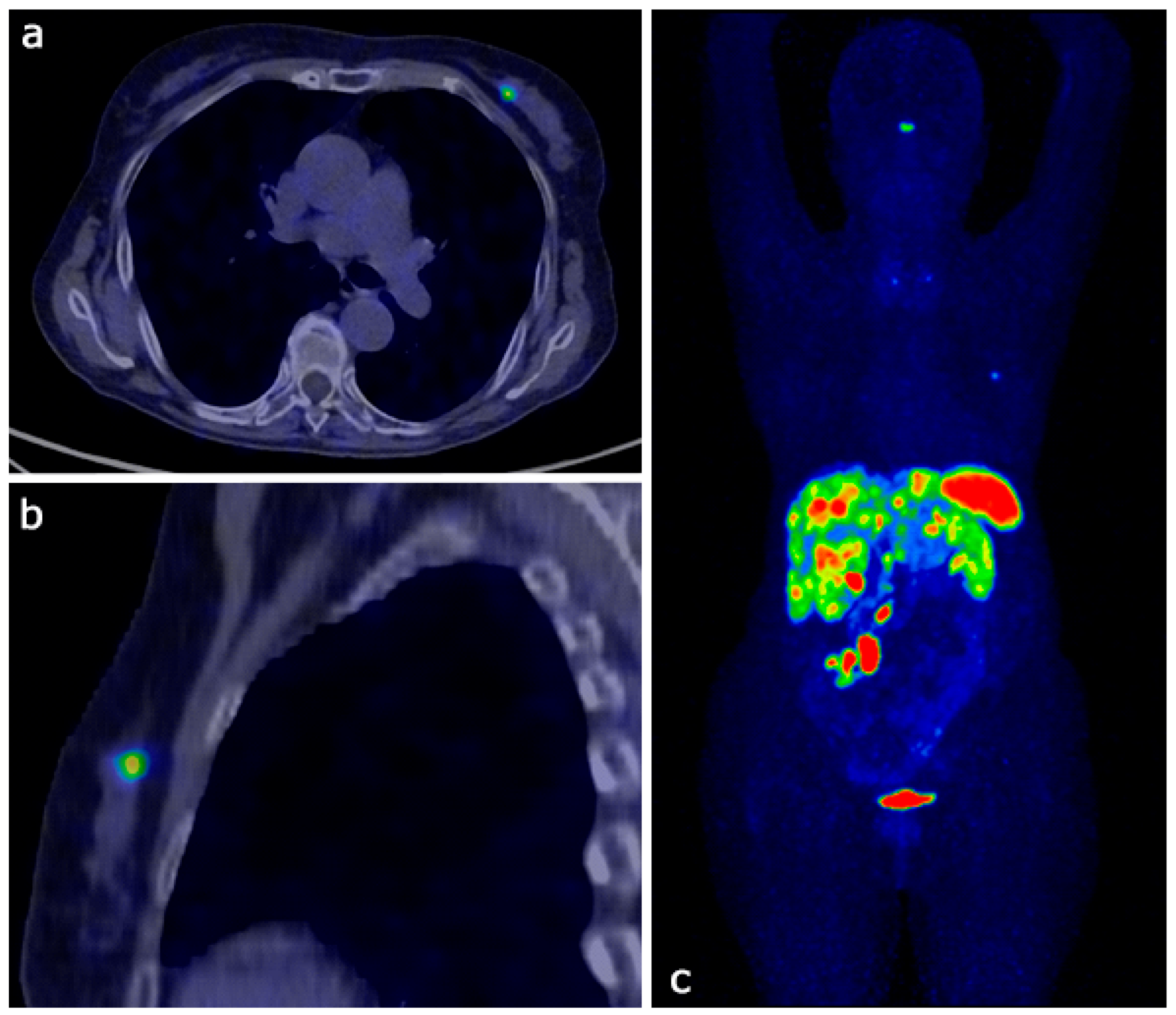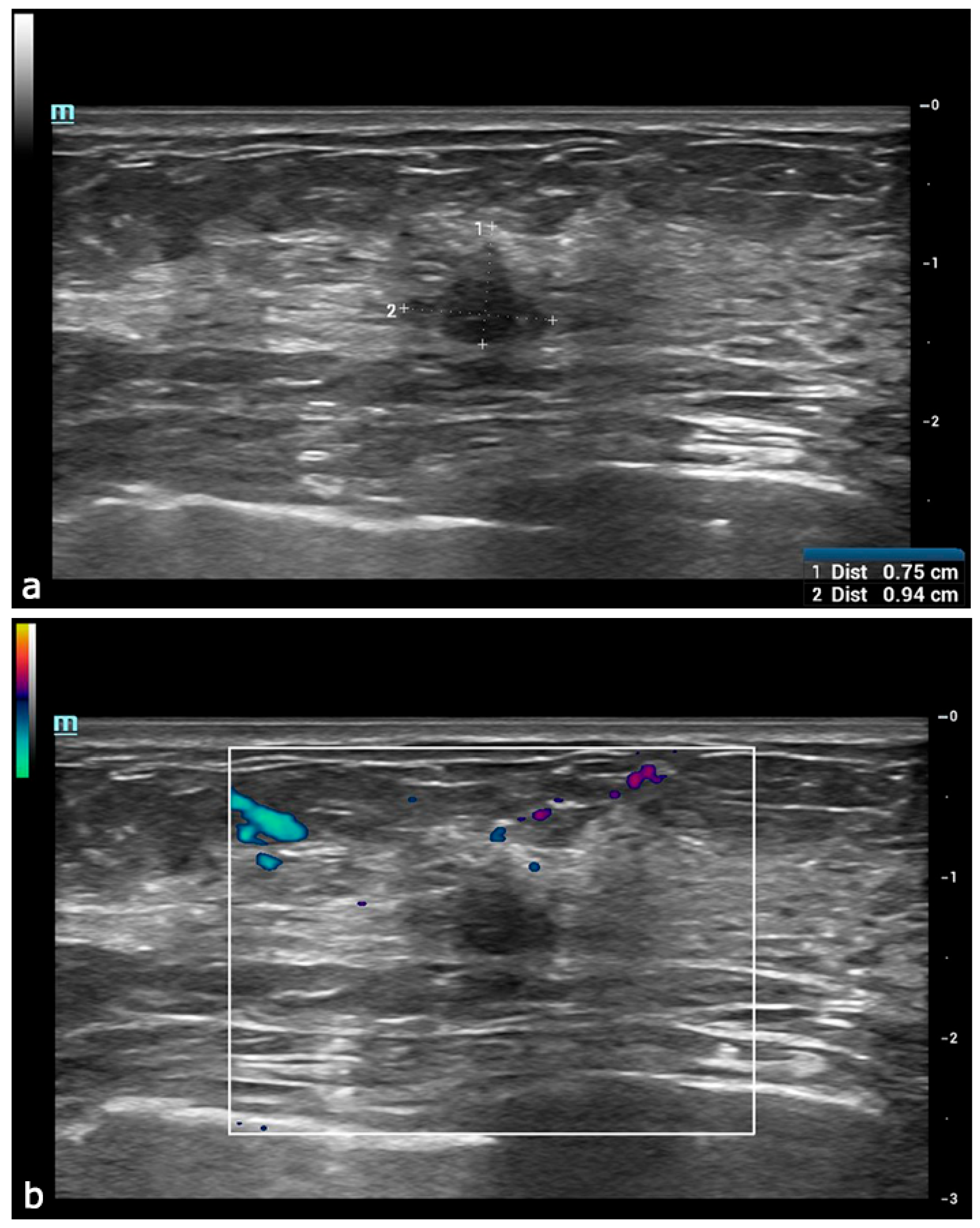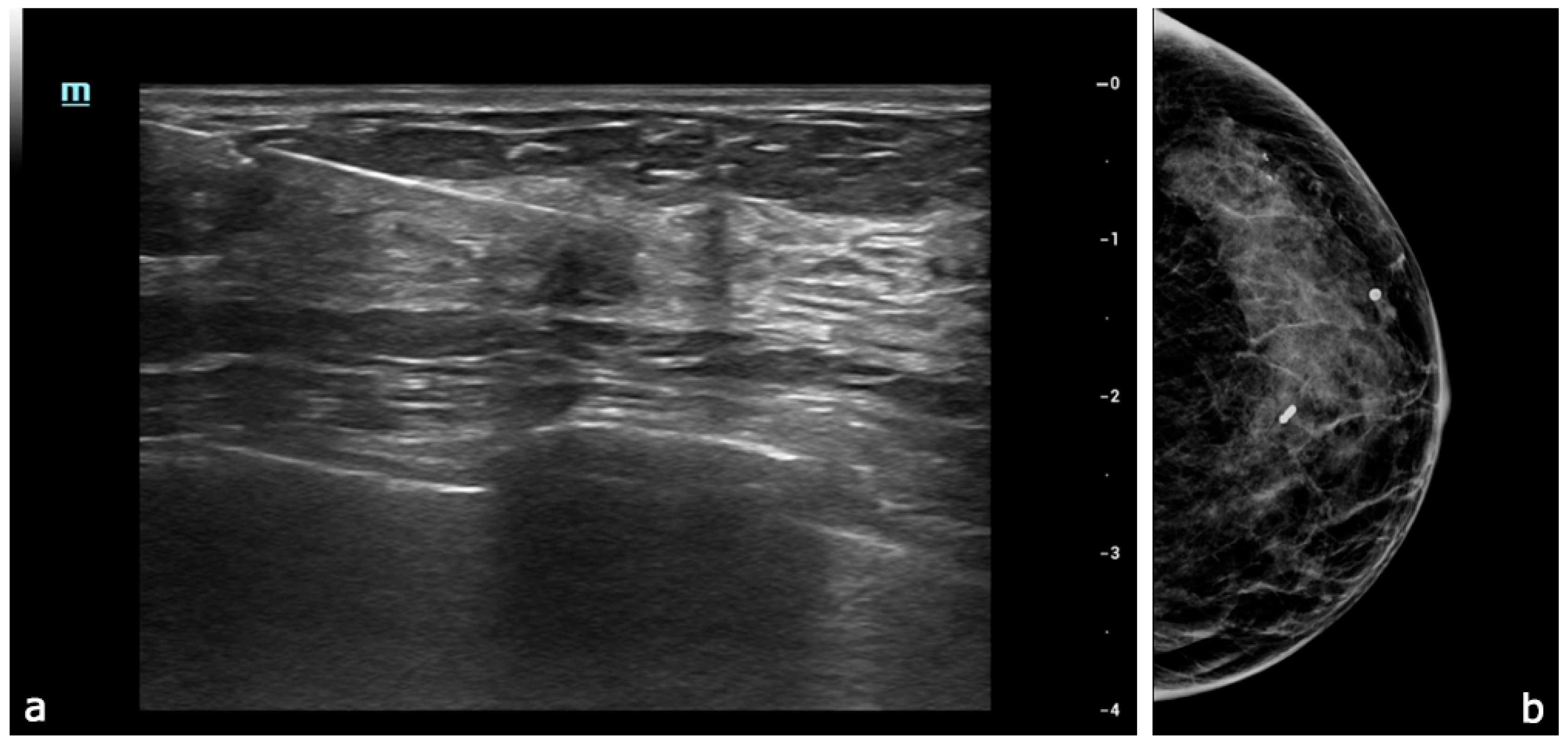Neuroendocrine Tumor Metastases to the Breast Mimic Breast Primary Carcinoma: Mammography and Multimodality US Assessment in Challenging Differential Diagnosis
Abstract







Author Contributions
Funding
Institutional Review Board Statement
Informed Consent Statement
Data Availability Statement
Conflicts of Interest
References
- Vergier, B.; Trojani, M.; De Mascarel, I.; Coindre, J.; Le Treut, A. Metastases to the breast: Differential diagnosis from primary breast carcinoma. J. Surg. Oncol. 1991, 48, 112–116. [Google Scholar] [CrossRef] [PubMed]
- Feder, J.M.; de Paredes, E.S.; Hogge, J.P.; Wilken, J.J. Unusual Breast Lesions: Radiologic-Pathologic Correlation. RadioGraphics 1999, 19, S11–S26. [Google Scholar] [CrossRef] [PubMed]
- Li, J.; Wahab, R.; Brown, A.L.; Guarnieri, B.; Lewis, K.; Mahoney, M.C.; Vijapura, C. Extramammary Metastases to the Breast. RadioGraphics 2023, 43, e230036. [Google Scholar] [CrossRef] [PubMed]
- Naswa, N.; Sharma, P.; Kumar, R.; Malhotra, A.; Bal, C. Usual and Unusual Neuroendocrine Tumor Metastases on 68Ga-DOTANOC PET/CT. Clin. Nucl. Med. 2013, 38, e239–e245. [Google Scholar] [CrossRef]
- Crona, J.; Granberg, D.; Norlén, O.; Wärnberg, F.; Stålberg, P.; Hellman, P.; Björklund, P. Metastases from Neuroendocrine Tumors to the Breast Are More Common than Previously Thought. A Diagnostic Pitfall? World J. Surg. 2013, 37, 1701–1706. [Google Scholar] [CrossRef]
- La Rosa, S.; Casnedi, S.; Maragliano, R.; Goyault, G.; Weber, J.-C.; Louis, B.; Schlund, E.; Sessa, F. Breast Metastasis as the First Clinical Manifestation of Ileal Neuroendocrine Tumor. A Challenging Diagnosis with Relevant Clinical Implications. Endocr. Pathol. 2015, 26, 145–151. [Google Scholar] [CrossRef]
- Wedin, M.; Janson, E.T.; Wallin, G.; Sundin, A.; Daskalakis, K. Prevalence of metastases outside the liver and abdominal lymph nodes on 68Ga-DOTATOC-PET/CT in patients with small intestinal and pancreatic neuroendocrine tumours. J. Neuroendocr. 2024, 36, e13391. [Google Scholar] [CrossRef]
- Wild, D.; Bomanji, J.B.; Benkert, P.; Maecke, H.; Ell, P.J.; Reubi, J.C.; Caplin, M.E. Comparison of 68Ga-DOTANOC and 68Ga-DOTATATE PET/CT Within Patients with Gastroenteropancreatic Neuroendocrine Tumors. J. Nucl. Med. 2013, 54, 364–372. [Google Scholar] [CrossRef]
- Mirzaei, S.; Revheim, M.-E.; Raynor, W.; Zehetner, W.; Knoll, P.; Zandieh, S.; Alavi, A. 64Cu-DOTATOC PET-CT in Patients with Neuroendocrine Tumors. Oncol. Ther. 2019, 8, 125–131. [Google Scholar] [CrossRef]
- Sundin, A.; Arnold, R.; Baudin, E.; Cwikla, J.B.; Eriksson, B.; Fanti, S.; Fazio, N.; Giammarile, F.; Hicks, R.J.; Kjaer, A.; et al. ENETS Consensus Guidelines for the Standards of Care in Neuroendocrine Tumors: Radiological, Nuclear Medicine and Hybrid Imaging. Neuroendocrinology 2017, 105, 212–244. [Google Scholar] [CrossRef]
- Balma, M.; Liberini, V.; Racca, M.; Laudicella, R.; Bauckneht, M.; Buschiazzo, A.; Nicolotti, D.G.; Peano, S.; Bianchi, A.; Albano, G.; et al. Non-conventional and Investigational PET Radiotracers for Breast Cancer: A Systematic Review. Front. Med. 2022, 9, 881551. [Google Scholar] [CrossRef] [PubMed]
- Yamaga, L.Y.I.; Wagner, J.; Funari, M.B.d.G. 68Ga-DOTATATE PET/CT in Nonneuroendocrine Tumors. Clin. Nucl. Med. 2017, 42, e313–e316. [Google Scholar] [CrossRef] [PubMed]
- Ambinder, E.B.; Werner, R.A.; Rowe, S.P. Incidental primary breast cancer detected on surveillance 68Ga-DOTATATE PET/CT in a patient with metastatic neuroendocrine carcinoma. Radiol. Case Rep. 2020, 15, 1344–1347. [Google Scholar] [CrossRef] [PubMed]
- Adams, R.F.; Parulekar, V.; Hughes, C.; Kadour, M.J.; Talbot, D. Radiologic Characteristics and Management of Screen-Detected Metastatic Carcinoid Tumor of the Breast: A Case Report. Clin. Breast Cancer 2009, 9, 189–192. [Google Scholar] [CrossRef]
- Glazebrook, K.N.; Jones, K.N.; Dilaveri, C.A.; Perry, K.; Reynolds, C. Imaging features of carcinoid tumors metastatic to the breast. Cancer Imaging 2011, 11, 109–115. [Google Scholar] [CrossRef]
- Perry, K.D.; Reynolds, C.; Rosen, D.G.; Edgerton, M.E.; Albarracin, C.T.; Gilcrease, M.Z.; A Sahin, A.; Abraham, S.C.; Wu, Y. Metastatic neuroendocrine tumour in the breast: A potential mimic of in-situ and invasive mammary carcinoma. Histopathology 2011, 59, 619–630. [Google Scholar] [CrossRef]
- Park, S.Y.; Parihar, A.S.; Bodei, L.; Hope, T.A.; Mallak, N.; Millo, C.; Prasad, K.; Wilson, D.; Zukotynski, K.; Mittra, E. Somatostatin Receptor Imaging and Theranostics: Current Practice and Future Prospects. J. Nucl. Med. 2021, 62, 1323–1329. [Google Scholar] [CrossRef]
- Reubi, J.C.; Krenning, E. In Vitro Detection of Somatostatin Receptors in Human Tumors. Metabolism 1992, 41, 104–110. [Google Scholar]
- Cabrero, I.; Álvarez, M.; Montiel, D.; Tavassoli, F. Metastases to the breast. Eur. J. Surg. Oncol. EJSO 2003, 29, 854–855. [Google Scholar] [CrossRef]
- Youk, J.H.; Gweon, H.M.; Son, E.J.; Han, K.H.; Kim, J.-A. Diagnostic value of commercially available shear-wave elastography for breast cancers: Integration into BI-RADS classification with subcategories of category 4. Eur. Radiol. 2013, 23, 2695–2704. [Google Scholar] [CrossRef]
- Ito, T.; Manabe, H.; Kubota, M.; Komoike, Y. Current status and future perspectives of contrast-enhanced ultrasound diagnosis of breast lesions. J. Med. Ultrason. 2024, 51, 611–625. [Google Scholar] [CrossRef]
- Guirguis, M.S.; Adrada, B.E.; Surasi, D.S.M.; Dryden, M.J. 68Ga-DOTATATE Uptake in Primary Breast Cancer. Clin. Nucl. Med. 2020, 46, 248–249. [Google Scholar] [CrossRef]
- Thomassin-Naggara, I.; Kilburn-Toppin, F.; Athanasiou, A.; Forrai, G.; Ispas, M.; Lesaru, M.; Giannotti, E.; Pinker-Domenig, K.; Van Ongeval, C.; Mann, R.M.; et al. Misdiagnosis in breast imaging: A statement paper from European Society Breast Imaging (EUSOBI)—Part 1: The role of common errors in radiology in missed breast cancer and implications of misdiagnosis. Eur. Radiol. 2024, 1–10. [Google Scholar] [CrossRef]
- Thomassin-Naggara, I.; Athanasiou, A.; Kilburn-Toppin, F.; Forrai, G.; Ispas, M.; Lesaru, M.; Giannotti, E.; Pinker-Domenig, K.; Van Ongeval, C.; Mann, R.M.; et al. Misdiagnosis in breast imaging: A statement paper from European Society Breast Imaging (EUSOBI)—Part 2: Main causes of errors in breast imaging and recommendations from European Society of Breast Imaging to limit misdiagnosis. Eur. Radiol. 2024, 1–15. [Google Scholar] [CrossRef]
- Geyer, H.L.; Viney, J.; Karlin, N. Metastatic Carcinoid Presenting as a Breast Lesion. Curr. Oncol. 2010, 17, 73–77. [Google Scholar] [CrossRef][Green Version]
- Mosunjac, M.B.; Kochhar, R.; Mosunjac, M.I.; Lau, S.K. Primary Small Bowel Carcinoid Tumor with Bilateral Breast Metastases: Report of 2 Cases with Different Clinical Presentations. Arch. Pathol. Lab. Med. 2004, 128, 292–297. [Google Scholar] [CrossRef]
- Upalakalin, J.N.; Collins, L.C.; Tawa, N.; Parangi, S. Carcinoid tumors in the breast. Am. J. Surg. 2006, 191, 799–805. [Google Scholar] [CrossRef]
- Howe, J.R.; Cardona, K.; Fraker, D.L.; Kebebew, E.; Untch, B.R.; Wang, Y.-Z.; Law, C.H.; Liu, E.H.; Kim, M.K.; Menda, Y.; et al. The Surgical Management of Small Bowel Neuroendocrine Tumors. Pancreas 2017, 46, 715–731. [Google Scholar] [CrossRef]
Disclaimer/Publisher’s Note: The statements, opinions and data contained in all publications are solely those of the individual author(s) and contributor(s) and not of MDPI and/or the editor(s). MDPI and/or the editor(s) disclaim responsibility for any injury to people or property resulting from any ideas, methods, instructions or products referred to in the content. |
© 2025 by the authors. Licensee MDPI, Basel, Switzerland. This article is an open access article distributed under the terms and conditions of the Creative Commons Attribution (CC BY) license (https://creativecommons.org/licenses/by/4.0/).
Share and Cite
Aricò, F.M.; Portaluri, A.; Catanzariti, F.; Condorelli, E.; Aricò, D.; Zagami, M.; Magliolo, E.; Monforte, S.; Marino, M.A. Neuroendocrine Tumor Metastases to the Breast Mimic Breast Primary Carcinoma: Mammography and Multimodality US Assessment in Challenging Differential Diagnosis. Diagnostics 2025, 15, 860. https://doi.org/10.3390/diagnostics15070860
Aricò FM, Portaluri A, Catanzariti F, Condorelli E, Aricò D, Zagami M, Magliolo E, Monforte S, Marino MA. Neuroendocrine Tumor Metastases to the Breast Mimic Breast Primary Carcinoma: Mammography and Multimodality US Assessment in Challenging Differential Diagnosis. Diagnostics. 2025; 15(7):860. https://doi.org/10.3390/diagnostics15070860
Chicago/Turabian StyleAricò, Francesco Marcello, Antonio Portaluri, Francesca Catanzariti, Elvira Condorelli, Demetrio Aricò, Mariagiovanna Zagami, Emilia Magliolo, Sara Monforte, and Maria Adele Marino. 2025. "Neuroendocrine Tumor Metastases to the Breast Mimic Breast Primary Carcinoma: Mammography and Multimodality US Assessment in Challenging Differential Diagnosis" Diagnostics 15, no. 7: 860. https://doi.org/10.3390/diagnostics15070860
APA StyleAricò, F. M., Portaluri, A., Catanzariti, F., Condorelli, E., Aricò, D., Zagami, M., Magliolo, E., Monforte, S., & Marino, M. A. (2025). Neuroendocrine Tumor Metastases to the Breast Mimic Breast Primary Carcinoma: Mammography and Multimodality US Assessment in Challenging Differential Diagnosis. Diagnostics, 15(7), 860. https://doi.org/10.3390/diagnostics15070860





